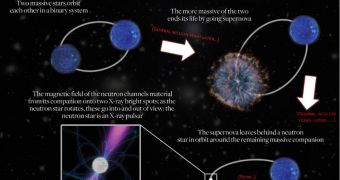In a paper published in the November 9 issue of the esteemed journal Nature, astrophysicists propose the existence of new flavors of super-dense objects called neutron stars. Thus far, they knew about pulsars and magnetars, but it could be that several other types of such stellar bodies may exist as well.
Each of the new breeds the team behind the study proposes is created by a different type of stellar explosion. Their existence was first proposed years ago, but thus far no research team was able to collect the necessary evidence to confirm such theories.
In the latest investigation, scientists analyzed a batch of about 100 high-mass X-ray binary systems, each of which contained a pair of neutron stars orbiting each other. Such systems provide the optimum settings for identifying various flavors of neutron stars, if they are to be found.
These objects are produced after massive stars go supernova, releasing the outer layers of their atmospheres, and forcing their cores to collapse into a small volume. Matter within this remnant is extremely dense, only less so than inside a black hole.
A neutron star the size of a small city can pack 1.5 times the mass of our Sun, meaning that a tablespoon of matter collected from such an object could weigh as much as an entire mountain.
“Theoreticians have speculated before about the possible existence of different types of neutron stars, but there has never been any clear observational evidence that there is really more than one type,” explains University of Southampton astrophysicist and study coauthor Malcolm Coe, quoted by Space.
He and his group focused on binary systems because neutron stars within have a tendency to accrete matter from their neighbors. This makes them start spinning considerably faster than usual, and researchers can draw important conclusions for studying these spin rates.
Two new, distinct classes of X-ray pulsars were found in the batch of 100 analyzed systems. Members of the first tended to complete a spin around their own axis in just 10 seconds. Objects in the second group needed as much as 5 minutes to complete a single spin.
“Our results suggest strongly for the first time that not all neutron stars are the same. There appear to be some subtle but important differences,” Coe adds. He says that neutron stars in the slower group also tended to have oval-shaped and more eccentric orbits than their faster counterparts.
The team now plans to conduct eccentricity measurements on the orbits of these planets, but that is not going to be an easy task. “We only see these objects intermittently. It may take a while to make the next step,” Coe concludes.

 14 DAY TRIAL //
14 DAY TRIAL //